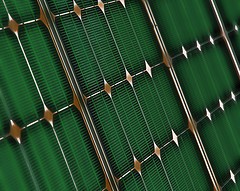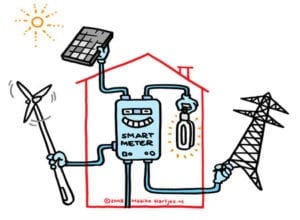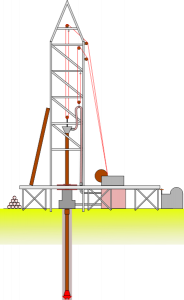
By now, 99% of us are aware of the problem. Cheap oil, whether due to peak oil or not, is over. Starting now, we need to wean ourselves off this expensive fossil fuel and find something sustainable. That is, an energy system that:
a) Is not subject to mining, and therefore will not be prone to depletion;
b) Sustains an active, healthy economy in a nationally secure setting.
The solutions appear to be endless, both in political and economic realms. Increase nuclear reactors? Run cars on natural gas? Burn trash for energy? Institute stringent speed limits and cap-and-trade programs?
Business Pundit sorted through a slew of reports, comments, and statistics to come up with a plan that makes sense for both sustainability and the economy. This plan is a compilation of the ideas we found most pertinent and useful. (Sources are linked throughout.)
The seven main points of the plan are as follows:
1) The ultimate goals of a sustainable national energy structure are electrification, flex power, and a smart grid.
2) Flex power should be based on large-scale nuclear, wind and solar power, supplemented by localized alternative energy sources.
3) Flex power sources will feed into an adaptable smart grid, whose use ebbs and flows based on actual capacity.
4) Electrify transportation through increased rail infrastructure, suburban restructuring, and electric vehicles.
5) Wean the economy from grease to juice by upping natural gas usage and conservatively drilling for oil while manically focusing on the smart grid, flex energy, and electrification.
6) Cut personal, industrial, and commercial demand through market forces and regulation to transition from oil to flex power.
7) Use the resources we have—the electric grid, buildings, trains—and adapt them to become sustainable.
The Business Pundit Energy Plan is divided into four parts.
1. First, a brief background.
2. Next, a detailed plan on what we need to do right now in order to get on the right path. Much of this section has to do with regulations to help the market re-gear demand to a more sustainable future.
3. Section 3 has to do with medium-term issues like offshore drilling and natural gas.
4. Section 4 details what our long-term future should look like. It includes descriptions of the smart grid, flex power, and what energy sources will work best to feed this system.
Let’s look at a couple of facts before getting started:
FACT 1: Overall energy use
We’re the biggest overall consumers of energy in the world.
Where does our overall energy come from?
40% oil (60% imported; 16% of imports from the Persian Gulf.)
23% natural gas.
22% coal
8% nuclear
7% renewables
FACT 2: Electricity Use
Where does our electricity come from?
49% coal
22% natural gas
19% nuclear
6% hydropower
This plan assumes that the nation’s ultimate goal is to change those percentages so that coal and oil are in the minority, and nuclear and renewables, such as solar- and wind power, represent the largest percentages.
SECTION 2: Short-Term Action: Cut Consumption
The United States consumes more electricity than any other nation on Earth. At current consumption rates, existing energy sources will run low and become prohibitively expensive.
Market forces, government incentives and real production costs are key elements to driving down consumption and keeping energy affordable for everyone. By following the steps below, we can successfully drive down consumption in the short-term:
1. Put Up a Nationwide Challenge
Al Gore put up a new national challenge for the US to produce carbon-free electricity within ten years. He advocates using that power for electric vehicles. Is it feasible in 10 years?
Yes, if we can somehow come up with $5 trillion (an estimate by US News and World Report’s James Pethokoukis). The spirit of the plan is in the right place; our finances are not.
The solution is to create a more feasible—but challenging—10-year-estimate, and follow through with it. The following targets are examples:
-Cut energy consumption by 1 million barrels/day by 2018.
-Put solar panels on 20 million homes by 2020.
-Stretch Gore’s plan by 10 years, so that the US produces carbon-free electricity by 2028.
-Take inspiration from the Pickens Plan and power 20% of the nation using wind within 20 years.
-Power all city buses, government transport vehicles, and airport transportation vehicles/shuttles with natural gas by 2015.
-Get 25% of each state’s population in an alternative fuel or electric vehicle by 2015, using state and federal incentives as bait.
2. Use Corporate Contests to Fast-Track the Greening Process
Any company that gets ahead quickly will cut costs and maintain an advantage over its competitors. Dow Chemical has hosted energy-saving contests among its employees since 1982. Resultant projects have saved it a grand total of about $75 million a year. Contests not only help contribute to energy savings, but afford companies good PR and a competitive advantage as well.
3. Implement a Series of National Utility Company Regulations
a. Get utilities companies to charge real-time rates. Currently, utilities companies charge the same regardless of whether consumers are using power at peak- or base-load times. Electricity used during peak times (4-10pm) is generally more expensive and wasteful because it’s powered by gas turbines. If utility companies charge by actual costs, use during peak times will go down (credit: NapalmGod at Salon)
b. Require smart metering. Smart power meters give instant feedback on the amount and source of power consumers are using. Some say that users reduce their consumption by as much as 15% when using smart meters. The government needs to mandate that electricity companies install these in every residence and business.
c. Make energy companies buy solar energy. Germany tried this out with excellent results. Mandate that power companies buy 20 years’ worth of solar power at a significant markup. This gives energy companies a strong incentive to make their new energy burden (solar) profitable. Now, solar power is burgeoning in Germany, and is expected to create up to 90,000 new jobs in the next five years.
d. Mandate co-generation in industry. Co-generation means reusing the heat that your energy source gives off as a by-product. That heat can be channeled into another resource. (Credit: dcmeserve from Salon). Work with existing (fossil fuel) plants to encourage them to reduce emissions and co-generate. Why reinvent the wheel when existing power plants can change their practices? Send in government contractors to evaluate plants and repower them where possible.
e. Focus on the worst polluters. This Salon article states that the paper, pulp, steel, aluminum, petroleum, and chemicals manufacturers consume 80% of industrial energy in the United States, as well as produce most of the country’s hazardous waste. Start here to increase efficiency and cut pollution.
f. Regulate retail and outdoor energy use. Some electronics stores keep TVs and other products running 24 hours a day. Malls, downtown areas, and homes also keep some lights on unnecessarily at night. Mandate a “lights-out” time for these energy consumers, or they face a fine. Keep only those lights on that are necessary for public safety (holiday lights don’t count).
g. Require facility upgrades or tougher energy use standards in buildings to make them more energy-efficient. Check compliance with energy meter and barometer.
h. Build more efficient household appliances and non-car vehicles. Require that manufacturers make household appliances, motorcycles, lawnmowers, ATVs, etc. more fuel- and energy-efficient. Apply manufacturing standards to a long list of such items.
4. Let States Determine Interior Energy Policies
a. Don’t interfere. According to this Washington Post article, the Bush administration was getting in the way of a rail line extension to Virginia’s Dulles National Airport, a project paid for with local funds.
This kind of interference should not be happening. The Federal government should draft legislation around supporting state energy restructuring, even funding it in certain situations, but otherwise leave states alone. Federal conservation and efficiency mandates should be minimal, with strong incentives for good performance.
b. Support state energy plans and give states autonomy to exploit their natural energy advantages.
For example, Vermont’s plan involves establishing “green energy zones” focused exclusively on developing renewable energy within the state. It is in a special position to leverage proximity to Quebec’s hydropower. Arizona, on the other hand, is in a prime position to use solar power. Yellowstone is in a good place to leverage geothermal power. Each area has different assets; leveraging them will get results faster.
5. Accelerate Greening Through Incentives and Taxes
a. Implement carbon taxes. Do this on the state level. Temporarily exempt natural gas (for a number of years) so that it can be used as an interim fuel, until the nation is mostly electrified. Use British Colombia’s model of $10/ton.
Avoid a middle-class revolution by adding a carbon tax to all transportation and utilities industries, while cutting payroll taxes to keep people financially solvent.
b. Give substantial tax credits to people manufacturing wind turbines and solar cells. Encourage independent power production this way. People sensing a deal will automatically use the resources around them to produce the best kind of renewable energy for their region. Permits for renewable projects generally come in faster than those for, say, nuclear plants, so people could get independent energy up and running sooner.
c. Increase gas taxes. They hover somewhere around 50 cents/gallon, on average. Triple gas taxes to $1.50 further cut demand. (Businesses currently get 58 cents/gallon refunded; increase the refund proportionally to gas taxes, so that small businesses aren’t put out of commission.) An eventual petrol price increase to $10/gallon would put the US on level footing with other nations. Use gas and petroleum import taxes to fund the new smart grid. Raise taxes over a period of a decade or two, until demand decreases drastically.
d. Give homeowners tax credits when they install solar panels.
e. Keep small business intact with tax rebates. Offer incentives to convert business vehicles to natural gas. Don’t tax natural gas in the beginning, so refueling will be cheaper. Convert all mass transit to natural gas or electricity.
f. Launch a nationwide educational campaign. This campaign will teach local governments and communities how to create their own wind- and solar-powered renewable power plants. Offer federal incentives for starting that kind of project.
6. Cut Speculation
Part of the oil problem has to do with speculation leading to an oil bubble. Stopping speculation will keep prices closer to their real market value while we look for medium- and long-term solutions.
Barack Obama has good ideas in this realm. His energy plan calls for “fully closing the Enron loophole.” The Enron Loophole stops the Commodity Futures Trading Commission from regulating the oil futures market effectively. Regulating oil futures will stall harmful speculation.
The plan also calls on the FTC and Department of Justice to investigate oil futures manipulation. Gaining transparency will be key to establishing a market closer to the actual price of these commodities.
SECTION 3: Medium-Term Action: Oil to Flex Power
Unless Al Gore mobilizes a band of a million or more idealists within the year, an electrified economy won’t pop up in ten years. Instead, we need to invest heavily in R&D and restructuring while weaning ourselves off fossil fuels.
How do we wean an economy from grease to juice? By upping natural gas use, and gaining oil independence. At the same time, we need to focus on restructuring buildings and transportation systems based on the oil economy. We can accomplish this by increasing rail transportation, greening buildings, and regulating transportation.
1. Use Natural Gas As An Interim Fossil Fuel
Natural gas, like oil, is a liquid with high energy potential. However, this fossil fuel has limited supply (in fact, shale deposit wells tend to decline 50% during the first year of extraction, and are often exhausted in four years).
High demand would require incredible amounts of drilling, and there’s debate as to whether supply could keep up for long. There’s no point in pouring hundreds of millions of dollars into a transportation economy based around another fossil fuel with limited reserves.
Natural gas, however, can still play a role as an interim fuel. Natural gas runs cleaner than petroleum-based fuels. The United States currently has a surplus of natural gas in storage, making it an ideal near-term fuel to power transportation while we wean off oil and optimize a smart grid.
2. Drill Conservatively for Oil while Focusing on Building a Flex Power Infrastructure
Many areas in the United States are already open for drilling. President Bush is encouraging Congress to open up offshore drilling (much of it off the California coast).
Opponents say this is simply another way to cater to energy companies’ profits, and that the oil will take a decade to come online. Proponents say we need more oil, that our dependence on oil will last well into the next decade, and that offshore drilling now will give us the oil we need later.
The problem is that recent oil crises (1974, for example) have panned out as follows: High oil prices lead to call for conservation and alternative energy. However, oil prices stabilize or fall, and we stay dependent on a shrinking oil supply.
Supply these days appears to be too small to continue on with this mentality. For that reason, putting the bulk of our financial might and brainpower into electrification, coupled with a conservative approach to offshore drilling, is the smartest long-term solution.
Put forth a mandate that oil companies drill on the land they’re leasing before allowing them to claim offshore drilling sites. Fast-track offshore sites that can be put online in less than ten years (Santa Barbara is an example).
Per current media reports, importing oil is easiest, but using existing land leases is, for oil companies, most difficult. If this is true, then we need to gear policies away from what’s easiest for oil companies and towards what works best for a sustainable future.
Opening up everything for drilling right away, as Bush intends, is short-sighted. Oil could very well quintuple in value over the next ten years. If there’s none left in the ground, we lose in the long run.
In a ten-year period:
-Solar technology will have improved enough to make it competitive with petroleum.
-If we’re aggressive enough, we can power 21% of the nation on wind (according to the Pickens Plan).
-Significant progress could be made towards creating a smart grid with flex power.
Why drill as though it’s the end of the world? Drill smart, but put most resources towards getting out of the fossil fuel paradigm for good.
4. Change National Standards for Buildings and Infrastructure
Build Green: One McKinsey report (via Salon) last year discovered that “improving energy efficiency in buildings, appliances and factories could offset almost all of the projected demand for electricity in 2030.” Efficient buildings and equipment, in other words, pay off handsomely.
Get architects and civil engineers on task, now, to create buildings that are well-insulated, do not require air conditioning (possible in some parts of the world), and are solar-powered. Put up building standards. According to the the same Salon article, fixing leaky air ducts may cut electricity waste by up to 30%. White flat roofs on commercial buildings reflect sun, preventing buildings from getting too hot. LED traffic lights cut energy waste, too.
5. Regulate Automakers
There’s no need for tax credits for people to purchase high MPG vehicles—the market will take care of that after gas taxes go up. The same goes for speed limits. Make gas expensive enough, and innovation will follow.
Government regulation of automakers, however, will help. Require that a certain number of electric cars be built, along with a certain number of hybrids, each year. Offer R&D incentives for automakers who hit the goals within a year, two years, five years. Automakers can transfer those incentives to users as rebates. Offer tax credits for early adopters of electric cars, as well as electricity credits, if necessary.
As former Intel CEO Andy Grove says in Our Electric Future, improve gas-guzzler technology first. SUVs and pickups are the real problem, not gas-efficient compacts. Grove says that such a move could “cut petroleum imports by 50-60%.”
6. Restructure Roads and Railways
a) Build rails on roads, where possible, devoting one highway lane to intercity trains or light rails. Build high-speed rail lines along interstate highway routes, or the highways themselves, where feasible. Help pay for this reconstruction with oil revenues.
b)Consider the necessity of building new roads: What are the alternatives? Can a road be built from recycled materials?
c) Have states or the federal government put incentives, such as tax credits, in place for public transportation.
d) Build railroads. Railroads are energy-efficient replacements for freight trucks and commercial airliners, two big gas-guzzlers. Build up railroad infrastructure to replace air travel. Link cities with high-speed trains; use light rail for travel inside of cities. Electrify existing railroads, and provide railyards with loading equipment for freight. Use freight trains in place of highway freight.
7. Reform the Suburbs
They’re based on cars. Decades ago, some urban planners even refused to build sidewalks so that people would be incited to use cars to get everywhere. That mentality needs to be turned inside-out.
High density areas surrounded by open space will serve an energy-efficient future more effectively. Sprawling residential areas require larger amount of energy to sustain. Where possible, adapt existing spaces for higher density; build all new ones that way.
SECTION 4: Long-Term Goals: Electrification, flex power, and a smart grid

1. Electrification: What would an electrified world look like?
The days of the liquid economy are numbered. Substituting oil with natural gas, for example, wouldn’t work. Why not? Natural gas can only come from one place, while electricity comes from multiple sources: wind, solar, biomass, nuclear, coal, etc. Electricity is a more redundant and reliable energy standard.
Powering the entire economy, including most transportation, with electricity will keep us in business much longer than an exhaustible fossil fuel. Imagine a world of electric cars, big rigs, trains, and other vehicles that use plugs and chargers.
A new economic system could be built around the purchase of power for your vehicle. For example, frequent Salon commenter Dcmserve proposed a system where computers in cars could automatically buy and sell electricity to/from the grid at negotiated rates.
The point is that a rate system is workable. The infrastructure for electricity is here; we don’t have to reinvent the wheel, just some of the spokes.
The main reason we haven’t already gone electric is the transportation industry. According to Andy Grove’s piece on electrification,
The automobile industry, in the main, has not embraced disruptive technology. It has been waiting instead for batteries to improve until they can allow electric cars to enter the marketplace with the same driving range as gasoline-fueled cars. Battery developers, in turn, have been waiting for demand from the automobile industry to develop before fully committing the resources required to do the job.
That hesitation needs to transform into a sense of urgency. This can be accomplished through government policy (see subsequent pages). The technology needed for plug-in hybrid cars already exists, as does the kind of technology necessary to use electric cars for shorter distance trips (long-distance trips require advances in battery storage).
Going from gas to plugs is feasible. The missing link is a functional government that can nudge the industry in the right direction.
2. Smart Grid: Take advantage of peaks and lulls in energy capacity
Our energy system is modeled on a grid, which enables electricity to be stored, then produced energy when high demand requires it. We’re used to getting energy when we need it.
A smart grid is engineered to handle load energy (nuclear, for example) as well as intermittent energy, such as wind and solar. That way, with some discernment, we can still get energy when we need it. Solar matches well to peak times, for example; wind works well at night.
A smart grid also coordinates use of national and regional grids so they’re not overstressed at certain times. Lights-out policies at night while electric vehicles charge is an example. This kind of planning ensures that flexible energy sources are used efficiently, and avoids economy-busters like scheduled blackouts.
Fossil fuels such as oil and coal are instant sources of stored energy. If we are to wean ourselves off fossil fuels, storage factors also need to be considered.
3. Flex power: What do we need to feed the grid?
Flex power involves producing electricity using a variety of sources—solar, wind, hydroelectric, nuclear—and feeding this energy into the grid. Much of the grid infrastructure to transport energy to end users is already in place. Additionally, a flex grid can adapt remnants from the oil economy for energetic use. For example, car garages can be converted to host generators.
.
4. Key Energy Sources for the Flex Grid
Solar, wind and nuclear, along with localized renewables, are the mainstays of the Business Pundit energy plan.
a) Nuclear
Nuclear, in concert with wind and solar energy, will provide enough energy to run the new “smart grid.”
Nuclear power has, according to energy expert Joseph Romm, received around $100 billion in subsidies. Uranium costs are also increasing, making nuclear energy an expensive proposition. A nuclear plant may take up to 10 years to come online, but with fast-track government permission, a nuclear reactor may come online in as little as three years.
Why is nuclear energy worth it? A couple of reasons:
– It provides the kind of baseload that wind and solar do not. Nuclear is expensive, but in terms of baseload and carbon neutrality, there is no better alternative.
– Coal is currently the most widely-used form of electrical energy. This fossil fuel won’t last forever, and is a heavy contributor to global warming. Nukes provide the type of energy we need without the heavy carbon side-effects.
– Expenses can be kept in check by adapting uniform nuclear plant standards, which will enable plants to be constructed more quickly and efficiently. Right now, plants in the United States tend to be tailor-made for their localities, upping costs significantly.
– Nukes are safer than they used to be (for example, pebble bed reactors are proliferating in China). Reactors can be fueled from reprocessed waste (this currently isn’t done in the United States, but the next administration should change this regulation).
b) Wind
Wind, unlike nuclear facilities, can function on various different scales. Getting a large wind farm in place requires years of research, property acquisition, permits, etc. However, individual homeowners with land (at least ½ acre) can benefit from “small wind,” or a personal wind turbine that offsets their dependence on the existing grid.
The Pickens Plan says that large wind farms could eventually power up to 21% of the country. With adequate storage and a serious turbine farming spree, this could work. Wind, like all energy sources, isn’t flawless. It’s conditional (wind stops, turbines stop) and kills birds. On the other hand, it’s clean, and the United States has serious capacity for it, making it a good large-scale option.
c) Solar
Solar energy is optimally about 20% efficient, while biomass is a meager 1%. Petrol is about 25% efficient. This makes solar a cheap, viable, effective option as a primary form of national electricity.
The technology is constantly evolving. As solar cells become more efficient, technology becomes more scalable. As with wind, storage solutions present a problem, but with enough R&D, the most viable solutions will present themselves. Scientific American has an excellent, detailed article on solar energy.
d) Localized Renewables
Geothermal electricity, hydroelectricity, pellets, tidal power, and other localized energy sources should be used at the locations where they are best harnessed.
Resources across the nation are varied. For that reason, local solutions can often be implemented more rapidly than national ones. Pellet stoves work well in forested New England, but not in plains states. Wind turbines are most efficient in windy areas. Solar farms won’t do well during Alaskan winters, but Southwestern deserts are ideal for giant solar farms similar the one Europe is building in the Sahara.
Local renewables are also available to individuals and family. Micro-generation using small solar panels and wind generators doesn’t require a huge investment. Pellets (granulated solids used for heating) are affordable to individual residents. The bottom line: Use the resources that are available to you to contribute to the grid.
See Damon Clifford’s blog for more specific pros and cons on renewable energy sources.
Conclusion
The energy issue is complex, but with careful planning and immediate action, we can avoid undesirable outcomes associated with severe energy shortages. The best and brightest in the fields of energy sciences, economics, policy, governance, architecture, and sustainability need to devote themselves to resolving this issue.
Heads of government need to either support or get out of the way of the national energy restructuring process. Our new national energy policies need to be driven by experts, entrepreneurs, and smart regulation–not politics.
To see what some of the community’s best and brightest have to say about energy, please refer to The Oil Drum.
To see our presidential candidates’ energy plans, see McCain’s site and Obama’s site.
For more information on national energy bills, go here.
Image credits:
Image 1 (black and white power plant): Flickr user Davipt
Image 2 (light switch): slowguides.com
Image 3 (nighttime power plant): Flickr user judyboy
Image 4 (smart meter): MaaikeHaartjes.nl
Image 5 (Dulles International Airport): Flickr user Heaven’s Gate (John)
Image 6 (train): Pbase.com/herb1rm
Image 7 (oil derrick): Wikimedia commons
Image 8 (smart car): Flickr user Mikey G Ottowa
Image 9 (solar panel): flickr.com/photos/legrisak/
Image 10 (wind turbines): Flickr user Shandchem








